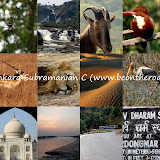Ken Gharial Sanctuary lies at the confluence of the Ken and the Khudar rivers in the Chattarpur district of Madhya Pradesh. Ken Gharial Sanctuary gets its name from the 6 meter long fish-eating Gharial, a rare species of crocodile. It is also home to wildlife species like sambar deer, blue bull (nilgai), peafowl, wild boar, spotted deer, chinkara and spotted deer. The Ken Gharial Sanctuary is part of the Gharial Conservation association where captive bred gharials are released to help regenerate the gharial ecosystem here.
I was stationed at Khajuraho and had spent an entire day and a half admiring temples, architectures and sculptures. After an overdose of history, I felt the need to get back into nature's arms. Thus, I decided to visit Ken Gharial Sanctuary, about 30 kms away from Khajuraho as part of a day trip. Locals had mentioned Raneh waterfall to me as a pretty tourist spot. One can even enter Ken Gharial Sanctuary from the other bank, which falls under the boundary of the Panna Tiger Reserve.

After riding through the countryside dotted with mustard fields, I reached Raneh falls. Named after King Rane Pratap, the erstwhile ruler here, this horseshoe waterfall tumbling down from a height of 30m is a pretty sight, though I guess it will look prettier post the monsoon season. It was here that I bought additional permits and gave lift to a forest department employee. Both of us reached the forest department enclosure nestled deep in the forest after crossing kacha mud roads. On our way to the forest department enclosure, we sighted Nilgai (Blue bull) and Sambar deer. Both of us made our way to a nearby view point armed with binoculars. The view took me by surprise as I scanned the interesting rock formations and the long and deep granite canyon. Through our binoculars, we spotted 2 adult gharials basking in the sun with some black storks in the vicinity.
While my forest guide was sharing his experience and narrating about the situation, I got to know that there maybe less than 200 mature breeding adult gharials left in the wild and they are listed as "critically endangered" in the IUCN Red List of Endangered Species. This entire sanctuary is struggling to cope with the habitat destruction and this is leading to faster disappearance of the gharials in spite of captive breeding by the Gharial Conservation Association.
The Gharial is a very beautiful reptile and I hope its numbers increase due to the conservation program and hope citizens of India do not end up troubling denizens of the wild.
To see India through the eyes of a motorcyclist's lens, visit the album below.
 |
| my solo all-india motorcycle journey |
I've still not written about all my experiences as a solo travelleer in MP. However, it is good to read about the places already visited from your posts. You have a good blog. Thank you for sharing your experiences and the beautiful images.
ReplyDeleteThank you Celine! The pleasure is mine!!
ReplyDeleteon march 04,2012 i Dr Ashwani K Dubey visited with 27 students of my college,I found surprising stage of ecosystem,warm climate,no water in river,no aqua mobile,no greenland,not good quqlity in borewell near office.so it is vulnerable to forest ecosystem.action is required for save raneh water fall especially can gharial beacuse without water what will be their
ReplyDeleteYes, it is a very sensitive ecosystem today. Hope the government wakes up and helps in reviving it.
ReplyDeleteYes, it is a very sensitive ecosystem today. Hope the government wakes up and helps in reviving it.
ReplyDeleteCan you tell me if there are public transportation available from Khajuraho to these places, like buses or shared cabs? Or do we have to hire private taxis?
ReplyDeleteAs far as I know, there are no buses on that route. Taxis are there and may be if you can hook up with other travelers, you can do a shared cab thing. You can also rent motorbikes at Khajuraho.
ReplyDelete